Traditional and Modern Style Stoves
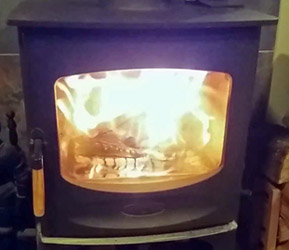
Wood
Burning Stoves
Questions and Answers,
Hints and Tips
Wood Burners:
up to
£1,500 | over £1,500 |
Multi-fuel:
up to £1,500
| over £1,500
Boiler stoves |
DEFRA approved stoves |
Inset stoves |
Logstore stoves |
Outdoor Logstores |
Stove Fans |
Electric |
Gas Stoves |
Stove Q and A's, hints and Tips
What is a DEFRA approved stove? Do I need one?
DEFRA sets the rules on where in the UK are "Smoke Control Areas". If you live in one of these areas you can only burn an authorised fuel, these being: anthracite semi-anthracite, gas, and low volatile steam coal OR unauthorised fuels such as wood as long as it is burnt in an exempt appliance such as a DEFRA approved woodburner or multifuel stove. This applies to England, the specific rules can differ according to where you live, Smoke Control Areas are generally found in cities and larger towns use this map to check if you need a DEFRA approved stove in your area.
Such stoves do not allow for long slow burns, such as overnight,
as these release more pollutants than a quicker cleaner burn.
Burning wood in an unapproved stove in a smoke controlled area
can lead to a fine. To receive DEFRA approval requires that
a particular model of stove passes the approval test which is
expensive and so stoves that could pass DEFRA
approval may not necessarily have done so if the
manufacturer hasn't p[aid for the test on that particular
model.
What is Eco-Design?
A European directive to improve the sustainability and efficiency
of a whole range of products, when applied to solid fuel burning
stoves it particularly refers to air pollution and particulate
emissions. Ecodesign stoves are certified as efficient
and clean burning producing few pollutants in the process.
Such a stove may or may not be DEFRA approved.
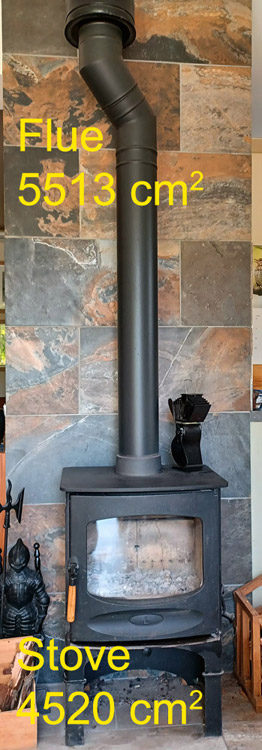 Positioning
the stove
Positioning
the stove
This will probably be out of your control to a large degree,
but if you do have the choice, a stove that is un-enclosed (as
opposed to in a fire-place for instance) will be more efficient
as more heat will be transferred to the surroundings of the
room. Likewise a stove with a long exposed flue in the room
will transfer more heat into the room along the length of the
flue than if it were enclosed within a chimney. I worked out
the surface area of the flue and box of my stove in the picture
to the right.
Wood burns best on a bed of its own ash
The good news is that you don't need to clean your wood burning stove out every day getting rid of yesterdays ashes. Wood leaves relatively little ash and it can stay in the stove to actually aid the fire on subsequent days only needing cleaning out when it gets deep enough to threaten to spill out. It is a bit "fluffy" when cold after building up the previous day, so I stir it up a bit with a kindling stick to settle it down before making the new fire.
This is not the case with smokeless coals
which make more ash and need cleaning out daily.
Starting
the fire
firelighters
+ kindling + smaller logs
Life is too short to be minimalist when lighting a fire with
screwed-up newspapers so buy a box of firelighters that are
used to start kindling which starts smaller logs before using
the bigger ones. Smaller logs burn faster and give a good blast
of heat to warm the room up before settling down to the slower
burn of larger logs. You will soon learn how to do this effectively,
I choose a flattish piece of firewood to put the firelighter on then
build a small structure around it with kindling with small logs
on top of this, air is as important as fuel so make sure there's
plenty of big gaps (as big as the spaces taken by the wood)
to let it in. Open the stove vents fully when starting the fire,
then close them to half-way once it's going.
Use burning newspaper to warm air in the flue and create a draw
Cold air is heavier than warm air, the air in the chimney
with an un-lit fire will be colder than the air in your
room, so the hot air from the newly-lit fire can find it
difficult to push its way out the chimney to start with.
This is ironically more so when the temperature outside is
closer to that in the room. If it's 10C or more outside I
loosely screw up a sheet of newspaper placed on top of the
built but un-lit fire, light the firelighter and then the
newspaper. The blast of hot air from the quickly burning
paper helps push the air up the chimney and get everything
going. The colder the outside air the less you need to do
this as warmer room air going up the chimney does the same
thing when you open the stove door to prepare the fire.
Use wood ash to clean the glass
Fortunately your wood burning stove makes its own ideal cleaning agent to get black marks and tar stains off the front glass, it is abrasive enough to remove the marks but not enough to scratch the glass.
When the stove is cold, fold a kitchen
paper towel into quarters and dampen it under the tap, dip the damp side into the ash, use this
to rub the black marks on the inside of the glass in a circular
motion. This will loosen the marks but smear the glass all over
with grey ash. Once the black marks have been loosened throw
this paper towel away and get another clean one, fold and dampen
again
and this time use it to wipe off the ash. If it's very dirty like mine was in the pictures,
you may need to use a couple of pieces of towel + ash to clean
it.
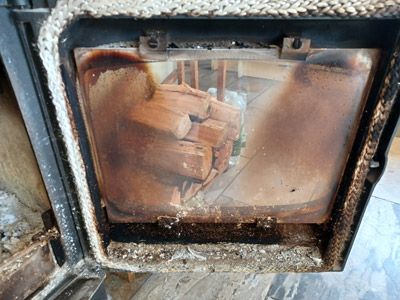
Very mucky stove door about to be cleaned.

Fold a kitchen paper towel into quarters and dip in the wood ash.
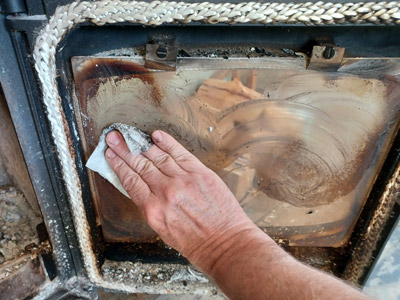
Wipe in circular motions to scrub off the deposits from the door.
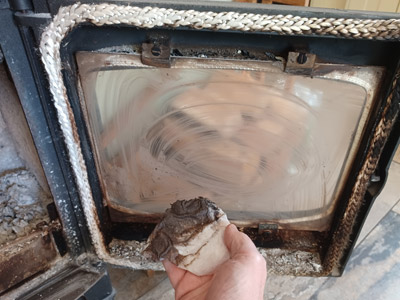
"clean" door but covered in ash,
this one took 2 goes.
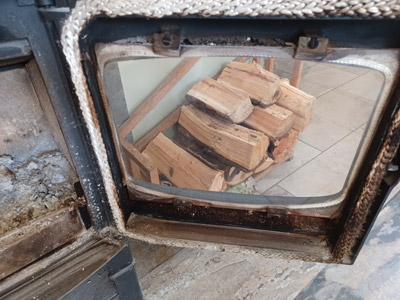
Wipe with another damp paper towel and it's all clean again.
Keep your wood dry!
Whether you buy your wood ready cut and dried or cut it yourself, it should be stored out of the rain until you are ready to use it in a woodstore. Damp wood won't light or burn as well as dry wood and produces FAR more smoke and particulate pollution. You also get much more heat from dry wood as it's not wasting energy turning all that soaked-in water into steam.
An open
fronted, roofed wood store near to the house is most convenient,
you can
buy or make one. Mine is 6ft long by 5ft high against
the house in a passage where the wind is funneled which helps
dry it out, I made it from scrap wood I had and spent about £30
on plastic sheets for the roof. I also have a larger roofed store at
the bottom of the garden that holds just over a years supply
of wood built onto the side of a shed.
Have a small store in the house to hold wood for a day or two
Have somewhere next to the stove to store wood so you don't
have to go outside on a cold dark night to get any. You also
want the wood to warm up before you use it to help it light
better, and it helps dry it out that bit more before
burning. DON'T have wood touching the outside of the stove
as it could catch fire but do have it nearby. I have a large
wicker basket one side and a rack I made on the other. In the
coldest days of winter between them they hold about 3 days worth
of fuel which is well over a weeks worth in spring and autumn.
Wood cutting tips
If you have access to a source of timber, cutting it up yourself can save you a load of cash compared to buying it ready cut and split, it's also a good work-out and cheaper than going to the gym! You'll need a chainsaw and a splitting axe or maul, a hand axe will be very useful too.
Things I have learnt:
- Cut and split the wood as soon as possible after
delivery or cutting the tree down, this speeds
up the drying process hugely compared to seasoning whole
uncut logs.
- Make sure you have a large enough woodstore
for the logs to dry out. This will ideally be
south-facing, and be open sided with a over-hanging roof
to allow the wind to help dry the logs out while keeping
the rain off. Use pallets, paving slabs or similar to
keep the logs off the bare earth and dry from beneath.
- Get a
sawhorse, preferably one that
holds several logs at the same time, it speeds things up
considerably.
- Use a larger log as a chopping block, preferably a crown piece, the knotty part at the top of the trunk where several branches come out.
Kindling
Any small pieces of wood that catch light easily and help get the fire going can be used as kindling. If you have no other source, get a hand axe and split larger stove-sized logs up to do this, you don't need many each time and a single log gives enough for 3+ days of starting fires.
If you split your own wood collect up the pieces of bark and smaller pieces that fall off into a porous bag and keep it on top of your wood pile, they make great no-effort kindling when dried out. Likewise if you do any kind of woodworking, have a kindling bin to throw in all those small offcuts you get.
You can buy bags of kindling for what always seems silly
prices to me when it is so easy to get otherwise.
Woody things NOT to burn...
- Any kind of manufactured wood product such as plywood,
MDF, particle board etc. these use large amounts of glue
which can release toxins when burnt.
- Painted wood.
- Treated wood impregnated with preservatives such as from fences, decks, sheds etc. either old or new off-cuts.
Wood Burners:
up to
£1,500 | over £1,500 |
Multi-fuel:
up to £1,500
| over £1,500
Boiler stoves |
DEFRA approved stoves |
Inset stoves |
Logstore stoves |
Outdoor Logstores |
Stove Fans |
Electric |
Gas Stoves |
Stove Q and A's, hints and Tips
Copyright 2000 - present. All Rights Reserved | Privacy Policy Statement
